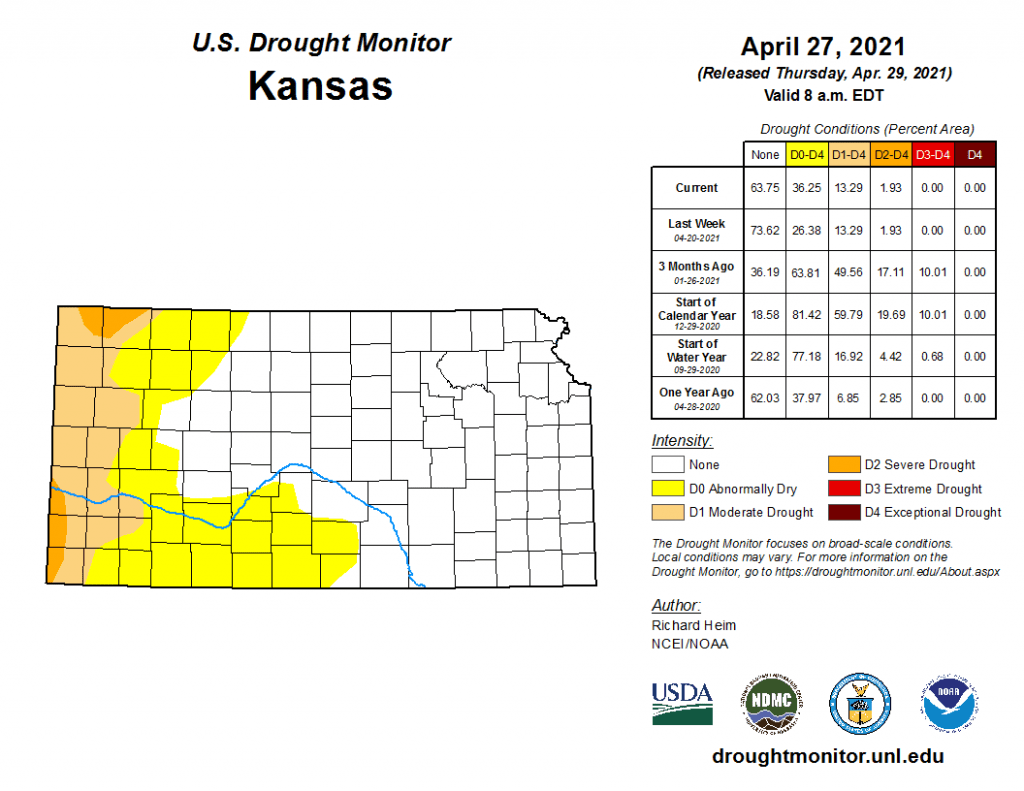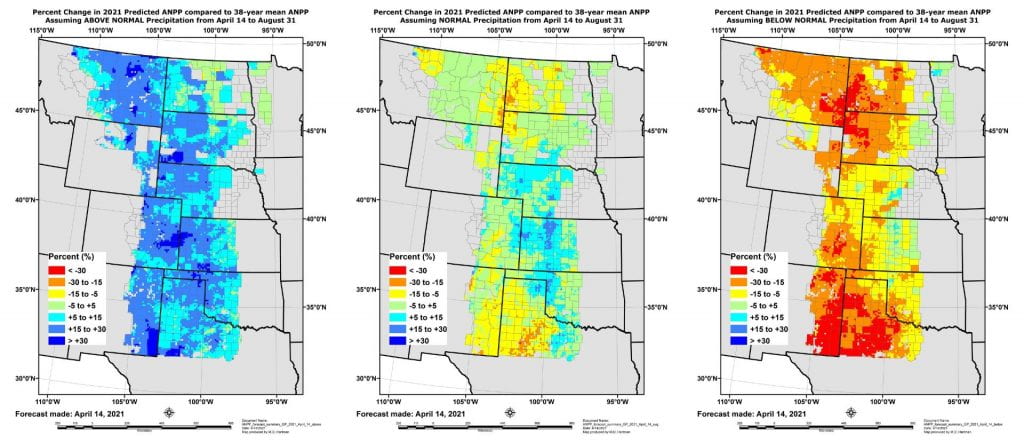by Walt Fick, Extension Rangeland Specialist
Drought in the Great Plains is a normal occurrence and inevitable. Drought occurs when an area receives less than 75% normal precipitation. Kansas is likely to have a drought 3 out of 10 years. When 2021 began, over 81% of the state was experiencing some level of drought. In the last report from the U.S. Drought Monitor (https://droughtmonitor.unl.edu), only western Kansas, or about 36% of the state, was experiencing abnormally dry to severe drought conditions (Figure 1).

If these conditions persist, stock pond levels decline, grasses show drought stress, hay demand will increase, fire danger increases, and blue-green algae may affect water quality. Reduced soil moisture, high air temperatures, reduced forage production, and a change in plant composition usually occurs with drought. Other reported impacts from drought can include culling of livestock and reduced stocking rates, increasing weed pressure, and emotional stress to humans.Two or more years of consecutive drought have far greater impact on vegetation than 1 year of drought followed by normal or above normal precipitation. Other drought monitoring tools can be found at (https://drought.unl.edu/droughtmonitoring/Tools.aspx).
What does the weather forecast look like for Kansas? The National Weather Service outlook for the next 30 to 90 days, indicates a 50-60% probability of above normal temperatures and a 33-40% probability of less than normal precipitation.
How much impact will weather have on forage production in 2021? Grass-Cast is an experimental (https://grasscast.unl.edu/?utm_medium=email&utm_source=govdelivery) grassland productivity forecast that predicts peak standing biomass for the season. It uses current weather data, seasonal climate outlooks, and a model to predict total biomass for individual counties, compared to a 38-year average. In Kansas, Grass-Cast, predicts for counties in about the western half of the state. Grass-Cast Maps predict based on above normal, normal, or below normal precipitation for a range of dates e.g. April 14 to August 31 (Figure 2). Historical productivity is also estimated using Grass-Cast, based on the years 1981-2018 (Table 1).

| Table 1. Grass-Cast estimated production (lbs/acre) for selected counties for the years 1981-2018. | |||
| County | Average Production | Minimum – Year | Maximum -Year |
| Lincoln | 3229 | 2383 – 1988 | 3812 – 1981 |
| Jewell | 2657 | 2308 – 2000 | 2904 – 2001 |
| Ness | 1388 | 972 – 2002 | 1749 – 1987 |
| Cheyenne | 1231 | 750 – 2002 | 1527 – 1981 |
| Morton | 1056 | 577 – 2011 | 1497 – 2017 |
What should a manager do or expect if hot, dry conditions persist going into the grazing season? Hopefully, they have a drought plan in place. Plant response will depend somewhat on the health of the pasture going into drought. Were the pastures stocked properly or were they being overgrazed? Heavy stocking can reduce root systems, making plants more vulnerable to drought. Moderate stocking rates and good grazing distribution allows pastures to recover more quickly. Rest is important to maintain vigor of the desirable plant species. Grazing systems incorporating more rest are apt to recover more quickly from drought.
What should a ranch drought plan involve? It should include a process to increase the health of the overall operation and maximize flexibility. The drought plan includes what to do during drought and when. Once drought is eminent, implement the plan and stick to it. A drought plan should also include strategies for restoring plant health after the drought. Drought plans are a dynamic process and may need to be changed/adjusted to make them work.
Drought plans generally identify critical dates and target points to implement the plan. Each critical date should have an action plan that clearly states target points for initiating the plan. Target points are often based on current forage production or amount of precipitation received. Critical dates start with prior to the grazing season, June 15, August 15, and end of the grazing season.
Management plans to alleviate the impacts of drought might include:
- Stock conservatively in good years.
- Cull cowherd closely when demand exceeds forage supply.
- Consider destocking or reducing stocking rate.
- Shorten breeding season.
- Wean calves early.
- Consider use of stockers and cow-calf.
- Manage livestock water supplies.
- Improve grazing distribution
Some closing thoughts. Reduce livestock numbers rather than feed harvested forages. Use good grazing management during and after drought. Stay flexible. Visit online the National Drought Mitigation Center http://drought.unl.edu/ranchplan. This site has a comprehensive publication on “Monitoring drought risks on the ranch: A planning guide for Great Plains ranchers.”